Let’s say you’ve collected keywords for a PPC campaign. What’s next?
You should organize them into groups to manage your campaigns conveniently and effectively. That is where you could start to see some problems. A chaotic grouping leads to low ad relevance, and decreases PPC performance.
In this article, we describe nine strategies for keyword grouping. There are no right or wrong approaches—they are all applicable in certain situations, and all have pros and cons. It is important to know these approaches to test them and, possibly, find ways to improve your campaign management.
Quick Links:
#1: Placing All the Keywords into One Ad Group
#2: Product-Based Keyword Grouping
#3: Morphology-Based Keyword Grouping
#4: IBAGs: Intent-Based Ad Groups
#5: Sales Funnel Based Ad Groups
#7: SKAG: Single Keyword Ad Groups
#8: Alpha/Beta Keyword Grouping
#9: Single Theme Ad Groups (STAGs)
To Wrap Up: Which Keyword Grouping Strategy is the Best?
#1: Placing All the Keywords into One Ad Group
The easiest way is to place all keywords into one ad group and create one or several ads for this group. Although this strategy may seem too general, sometimes it can be the right call.
![9 Win & Loss Strategies for PPC Keyword Grouping [+Examples]](https://blog.promonavigator.com/wp-content/uploads/2021/04/strategies-for-ppc-keyword-grouping-1.png) For all keywords within this ad group, the system will display one ad for an online copywriting course
For all keywords within this ad group, the system will display one ad for an online copywriting course
When to use the single ad group strategy
You can create one ad group per campaign in such cases:
- You are running ads for a single offer, with a short keyword list and one landing page.
- The bids for all keywords in your list are about the same.
- The target audience is homogeneous, and it makes no sense for you to create various ads to trigger different segments.
- Your task is to expand your keyword list. So, you run ads in a broad match with the basic keywords, collect new queries that triggered clicks, and add them to your main keyword list.
However, in most cases, this keyword grouping approach is ineffective, and it will lead to chaos in your account. It is better to systematize your keyword list in one of the ways highlighted below.
Pros:
- You don’t have to spend time organizing keywords into groups and creating ads for each group.
- You can quickly launch a campaign to test an idea or collect new queries.
- In this particular case, it’s easier to work with negative keywords. If you have only one ad group, the overlapping keywords shouldn’t trouble you.
Cons:
- Managing a campaign with a large number of keywords in one group becomes frustrating.
- Your ad group performance is unclear, and you can’t compare your results across ad groups.
- Adding dissimilar keywords to a single group reduces their Quality Score—meaning that it is harder for you to take a higher position without raising your bid.
- You can’t place entirely different keywords into the headlines and ad texts to increase the click-through rate.
- Bids for different keywords may vary, and you will overpay for clicks where you could save money (or you won’t drive clicks on expensive queries).
Anyway, this keyword grouping method is too basic. In most cases, you may find a better solution.
#2: Product-Based Keyword Grouping
In this case, you create single-product ad groups including keywords that relate to a specific product, service, or category.
For example, group A will be about engines, and group B—about car suspensions. This allows you to show relevant ads to users who search for the same products or services using different search terms but mean to reference the same thing.
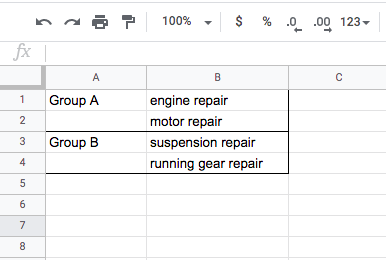 With the search terms “engine repair” and “motor repair,” users are looking for the same services
With the search terms “engine repair” and “motor repair,” users are looking for the same services
When to use the single-product ad groups strategy
The approach can be used, for example, when you do keyword research with the Google Keyword Planner.
Enter the name of the product or service, and you’ll get a list of search terms, including synonyms. If you add the keywords to one group, you will get a product-based keyword grouping.
![9 Win & Loss Strategies for PPC Keyword Grouping [+Examples]](https://blog.promonavigator.com/wp-content/uploads/2021/04/strategies-for-ppc-keyword-grouping-3.png) Keyword Planner provides you with relevant keywords for single-product ad groups
Keyword Planner provides you with relevant keywords for single-product ad groups
This strategy is often used by non-professional advertisers who set up ads for their own business and do not have much experience with keyword research. They go to the Keyword Planner, group the keywords by product, and launch the campaign.
But note that if you have several thousand keywords, then grouping synonyms will be very time-consuming and will make little sense.
Another issue is that product-based ad groups may contain keywords with not similar meaning. For example, keywords “buy fridge” and “fridge service” are related to the same product, but serve different user intentions and need different ad copies.
The strategy will also not work if you use manual bidding, and the bids for synonymous phrases differ several times, or there are many ambiguous queries.
7 Ways to Find the Best PPC Keywords [Guide to PPC Keyword Research]
Pros:
- This grouping method is easy to understand and implement—there are separate ad groups for different products, services, and categories.
Cons:
- With this approach, one group can include search queries entered by users with different search intentions.
- The bids for synonymous queries can differ. If we combine the keywords, we can’t effectively set bids at the ad group level.
![9 Win & Loss Strategies for PPC Keyword Grouping [+Examples]](https://blog.promonavigator.com/wp-content/uploads/2021/04/strategies-for-ppc-keyword-grouping-4.png) Different bids for similar queries
Different bids for similar queries
- If you combine many synonyms in one group, you’ll have to compose many ads. Alternatively, you can use dynamic keyword insertion to solve the problem partially.
 Dynamic keyword insertion in Google Ads
Dynamic keyword insertion in Google Ads
#3: Morphology-Based Keyword Grouping
By creating morphology-based ad groups, you organize phrases with the same basic words or word roots in one group. As a result, synonymous queries with different words will fall into different groups, and you may get several ad groups for the same products and landing pages.
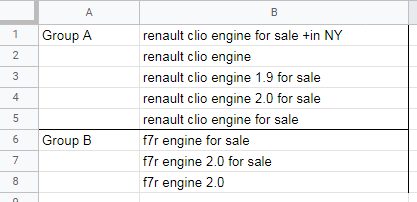 The groups include keywords with cognates
The groups include keywords with cognates
When to use morphology-based keyword grouping strategy
Morphology-based grouping requires consistent work with keywords. It is suitable for almost any topic with an extensive keyword list.
If you create relevant ads for queries, you increase the click-through rate (CTR). Also, queries that are essentially the same but different in morphology usually have a different cost per click (CPC). By dividing them into groups, you can manage bids more flexibly.
Pros:
- This keyword grouping method works for all niches.
- By making a separate ad group for each synonym, you can accurately place keywords in the headlines and ad texts, which will increase ad relevance and CTR.
- This approach allows you to get detailed statistics on groups and flexibly manage your ads. For example, you will know which ad group performs better: “cot buy online” or “cradle buy online.”
- It is convenient to group keywords by morphology—you can do keyword grouping in Excel or Google Sheets.
Cons:
- Consumers can use queries with the same root words but different intentions. For example, “buy a laptop” is a request from a retail customer, and “buy laptops” might be a request from a wholesale customer.
- Ads from different ad groups can appear for the same queries. To avoid competition between them, work closely with the negative keyword lists for each group. These negatives are called cross-group negative keywords.
If you use PromoNavi’s Campaign Builder, available in Keyword Planner Tool, you don’t need to find cross-group negatives manually—the process is fully automated here.
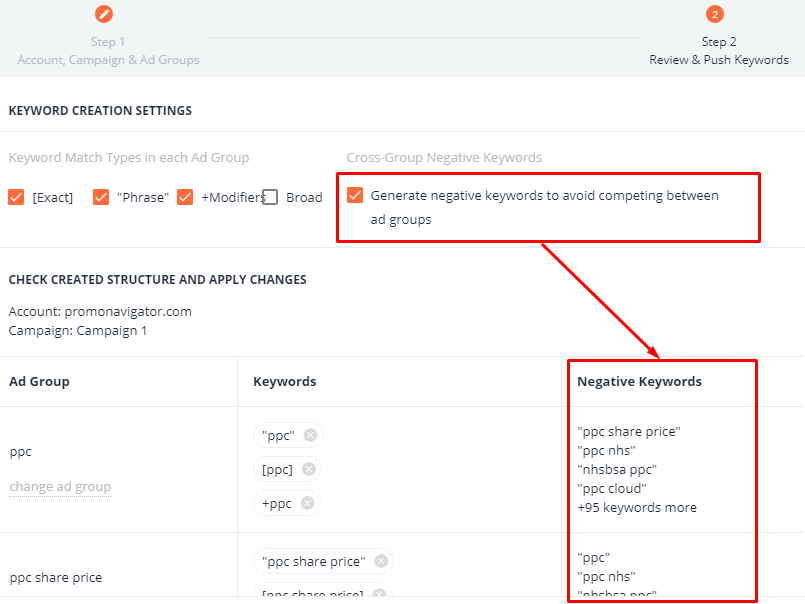 Cross-group negative keywords in PromoNavi
Cross-group negative keywords in PromoNavi
#4: IBAGs: Intent-Based Ad Groups
People who search for your product or service may have different intentions. Some of them need a product for personal use; others look for a wholesaler or product-related services.
Let’s look at the IBAG approach to keyword grouping using the example of interior doors.
We create three ad groups:
- For users looking for doors for their houses
- For users looking for wholesalers
- For users looking for door installation services
We put search terms with different intents into separate ad groups.
Compare these: if we group all these keywords by morphology, they will fall into the same ad group “interior doors.” However, for intent-based keyword grouping, we get three ad groups which are more specific and relevant.
The simplest option is to use keywords in a broad match. But, in this case, it is hard to control what ads will display for certain keywords. You will need to do a lot of work on negative keywords.
ECommerce PPC experts Store Growers suggest not to focus on keywords but create looser ad groups that combine keywords with the same intent. They call it IBAGs (Intent-Based Ad Groups). You need to put each keyword into the group by three match types: exact match, phrase match, and with a modifier. But as of February 2021, Google phased out the broad match modifier; so, when creating IBAGs, you should add keywords in exact and phrase match.
To avoid non-targeted impressions, you shouldn’t use only broad match keywords in IBAGs.
IBAGs is a variation of the SKAG approach (which we’ll talk about below). The difference is that, in each group, there is not only one keyword in two match types but several keywords in those match types.
When to use the strategy
Intent-Based Ad Groups can be more effective than product-based or morphology-based ones, but they require more resources. Therefore, it is advisable to use this method in the following cases:
- In complex niches with a long decision-making cycle, high competition, and expensive traffic.
- In any niche with a small keyword list, when you don’t have to spend weeks on keyword grouping.
Pros:
- Combining keywords by users’ intention, you can write more relevant ads than when grouping by product. That will increase your CTR and Ad Rank.
- When you analyze users’ intentions, you pay more attention to the purpose of search queries. You won’t add keywords to the same group that are morphologically similar but different in meaning.
Cons:
- IBAGs are more time-consuming and harder to automate than grouping by morphology. You need to go through the whole keyword list and choose keywords with similar intentions. Clustering helps to solve the problem partially—we will talk about this strategy below.
- With this approach, you may add morphologically dissimilar keywords to one group. Not all of them will fit into the titles and ad texts, but you can either increase the number of ads or use dynamic keyword insertion.
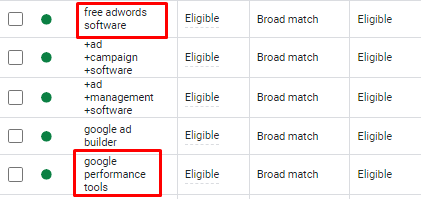 Words of different morphology with a similar intent
Words of different morphology with a similar intent
- IBAGs are not suitable for Smart Bidding strategies because the system won’t be able to optimize effectively for ad groups containing keywords in exact and phrase match. Smart Bidding strategies will be more effective for keywords in broad match.
How to Skyrocket Your Smart Bidding Performance: 10 Things to Check
#5: Sales Funnel Based Ad Groups
This approach is a particular case of intent-based grouping. At each stage of the sales funnel (Awareness, Attraction, Interest, Purchase, Delight) people use different search terms, and they need different kinds of information.
Grouping keywords according to this principle, we can create ad groups for consumers on the different levels of the sales funnel, for example:
- Users who search how to solve their problem, and they don’t know yet what product they need.
- Users who are interested in a product and are searching for the best one.
- Users who are ready to buy the exact product.
![9 Win & Loss Strategies for PPC Keyword Grouping [+Examples]](https://blog.promonavigator.com/wp-content/uploads/2021/04/strategies-for-ppc-keyword-grouping-10.png) Users who enter requests from the first group only want to know if the procedure will help them; from the second—are already interested in the price; from the third—are close to placing an order.
Users who enter requests from the first group only want to know if the procedure will help them; from the second—are already interested in the price; from the third—are close to placing an order.
Depending on your capabilities and budget, you can reach potential customers at all stages of the sales funnel or select some of them.
Pros:
- When you add keywords from the same stage of the funnel into one group, you show users relevant ads and lead them to the relevant landing page.
- When you «catch» users at the upper stages of the sales funnel, you can get cheaper clicks than on the funnel’s lower stages. Later, you can convert those visitors into buyers using lead-magnets, emails, and remarketing.
Cons:
- This approach is very time-consuming—you need to build a funnel, determine users’ intentions, and organize your keywords according to them.
#6: Keyword Clustering
In the strategies described above, we used different grouping criteria: product, intent, and morphology. But you can move the other way—rely on the search engines’ algorithms and their understanding of the search queries’ similarity.
Using this approach, you group queries based on the similarity of search results for them. We assume that if the first SERP results for specific queries are similar, search engines believe that they cover the same need. That means it makes sense to place them in one group.
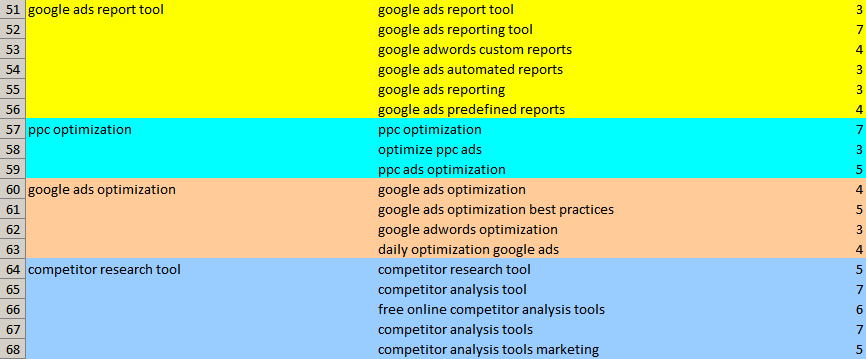 Fragment of a clustered keyword list
Fragment of a clustered keyword list
To automate keyword clustering, you can use PromoNavi’s Google Search & Display Campaign Builder. To get started, enter your website URL. The tool will analyze your website and suggest relevant keywords. After that, select keywords you want to target and proceed to the next step. Once done, the system will cluster keywords into ad groups and create ad texts for each group. Switch to the advanced mode to see which keywords are related to each group.
After keyword clustering and creating ad texts, you can complete the campaign setting up (define targeting settings, budget, ect.) and run the campaign directly from PromoNavi.
When to use the keyword clustering strategy
- Keyword clustering is useful when you need to quickly organize an extensive keyword list.
- This method can also be helpful for intent-based keyword grouping. You get enlarged clusters and can distribute them to ad groups manually.
Pros:
- Ads will be relevant not only to a user’s intent and morphology, but also to search engine algorithms.
- This keyword grouping approach can be automated—by leveraging keyword clustering tools, you save time on splitting keywords into groups manually.
Cons:
- Tools for clustering speed up the process, but keyword grouping still requires some manual effort.
- It can be challenging to determine the optimal clustering accuracy. At low (2-3), you can get clusters that are too broad; at high (6-7), they will be too granular. The optimal accuracy is 4-5, but you still need to look at the results to select the appropriate accuracy.
#7: SKAG: Single Keyword Ad Groups
SKAG is a long-known method for organizing campaigns. To each ad group, you should add one keyword in three match types: exact, phrase, and broad. You can then analyze the CTR and leave only the match type that performs the most effectively.
 An example of SKAG keyword grouping
An example of SKAG keyword grouping
When to use SKAGs
Use it when it is crucial to maximize ad relevance. SKAGs performs well for niches with expensive keywords, such as digital marketing, lawyers, etc.
Pros:
- The SKAG grouping is easy to understand—the methodology is simple.
- You can fully automate SKAG grouping. For example, with PromoNavi’s Campaign Builder, you don’t need to waste time on grouping keywords manually. Enable the option while creating a new campaign, and the tool generates SKAGs for each keyword. This feature is available in the both Keyword Planner and Competitor Analysis tool.
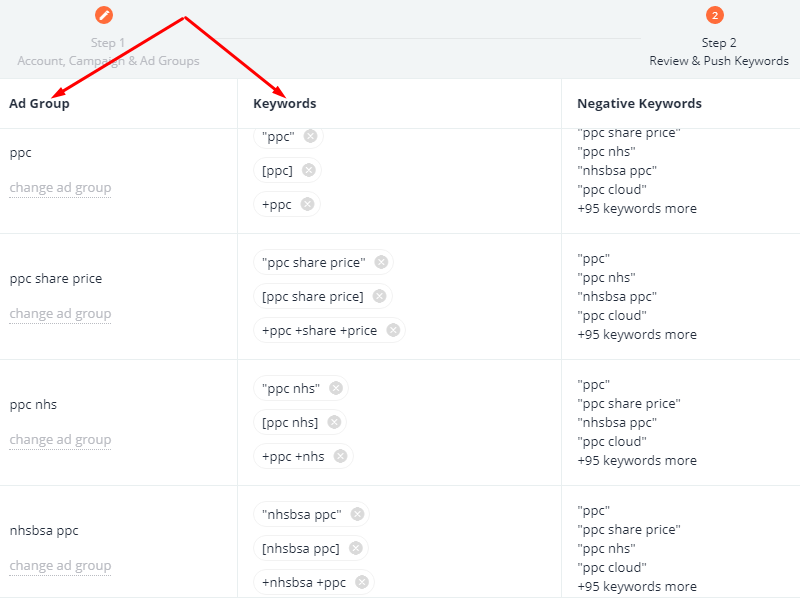 SKAG ad groups generated by PromoNavi
SKAG ad groups generated by PromoNavi
- Ads are perfectly tailored for keywords because you mention the search query in your ad. According to PPC best practices, it will improve your Quality Score.
- It is easier to optimize your campaign when you see detailed statistics for each keyword.
- When you focus on a single phrase in the group, it is more convenient to add negative keywords. You can use PromoNavi’s Add Negative Keywords tool to discover new negative keywords.
- With proper optimization, you can achieve high PPC efficiency.
Cons:
- Ad groups can compete against each other. They require a complex negative keyword set up, but you can automate it using PromoNavi’s Campaign Builder feature. Don’t forget to enable the Cross-Group Negative Keywords option.
- It is hard to test ads because of the groups and traffic granularity.
- You’ll have to manually optimize the campaign to add the majority of non-targeted queries to the list of negative keywords.
- Ads from ad groups with low-frequency keywords may not show.
- It’s challenging to manage an overview of a large number of ad groups. However, using PromoNavi, you can receive automated recommendations on how to improve your PPC campaigns.
#8: Alpha/Beta Keyword Grouping
Google Ads top experts Perry Marshall and Bryan Todd described this type of SKAG method in their book “Ultimate Guide to Google AdWords: How to Access 100 Million People in 10 Minutes.”
To apply this keyword grouping strategy, you should select the highest-converting phrases from a working Beta campaign and transfer them to the new Alpha campaign. In the Beta campaign, add these keywords to the negative keywords list.
Do this regularly—select the most effective keywords from the existing campaign and transfer them to the new one.
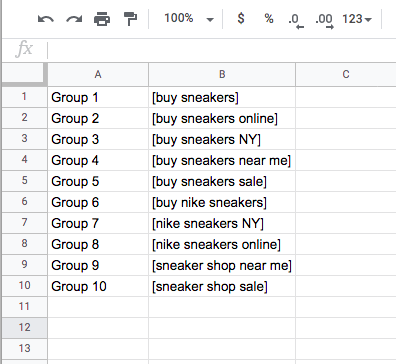 We created ten ad groups, each with one exact match keyword
We created ten ad groups, each with one exact match keyword
When to use the Alpha/Beta keyword grouping
Alpha/Beta grouping can be the right choice for complex niches when it is essential to increase conversions at optimal costs.
Pros:
- If you continuously add high-performing keywords to your Alpha campaign, you can increase conversions.
- If you allocate a larger budget to your Alpha campaign with high-performing keywords, you can maximize ROI.
Cons:
- A keyword with a high conversion rate in the Beta campaign can underperform in the Alpha campaign. As your budget and clicks increase, your conversion rate can drop.
- You need to regularly transfer high-performing keywords to the Alpha campaign and add them to the Beta campaign’s negative keyword list. That can be very time-consuming if you have an extensive keyword list.
#9: Single Theme Ad Groups (STAGs)
The STAG grouping method is the opposite of the SKAG. We create keyword groups that relate to a single narrow topic. There is no limit on the number of keywords, but they must match one specific theme.
Select one clear criterion (theme) for grouping—for example, price, features, etc.
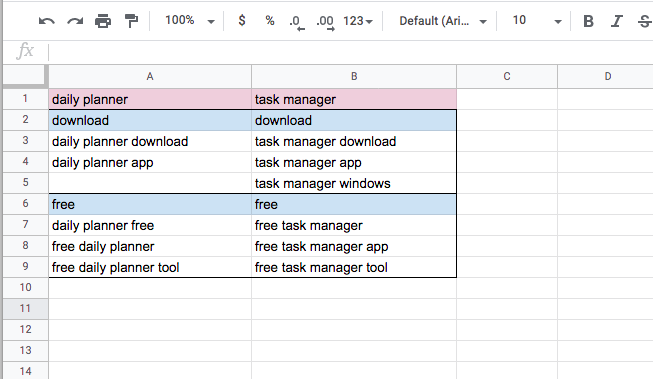 Example of STAG grouping with the themes “download” and “free”
Example of STAG grouping with the themes “download” and “free”
The method has a variation—20KAG, when the theme is implied by the 20 keyword limit, according to Google’s keyword guidelines.
Pros:
- With the STAG approach, you don’t need ads as much as in the case of using SKAGs.
- If you identify the right themes and form proper groups, you can create relevant ads and select the most appropriate landing pages.
- Single theme ad groups are suitable for Smart Bidding strategies such as Maximize conversions and Maximize conversion value. The system can better optimize for ad groups tailored on the theme basis.
Cons:
- It is not always possible to organize keyword lists into thematic groups.
- If you do not consider the user’s intentions and their sales funnel stage, you are risking showing ads to users looking for something completely different.
To Wrap Up: Which Keyword Grouping Strategy is the Best?
It is hard to choose an exact strategy and say that it is, hands down, the most effective one. A lot depends on the campaign goals, number of keywords, the specifics of the niche, the target audience’s behavior, budget, bid strategy, etc.
For example, you can manually organize keywords for a small keyword list depending on the intent or experiment with STAGs. If you are dealing with thousands of queries, you need automation—for example, grouping by morphology, clustering, or using the SKAG approach.
You can also combine several methods, test them, and find the best keyword grouping approach.
Do you want to save time promoting your business on Google, Microsoft, and social networks? PromoNavi provides marketers and business owners with a comprehensive toolkit to easily handle routine tasks, from keyword research and competitor analysis to reporting.
![9 Win & Loss Strategies for PPC Keyword Grouping [+Examples]](https://blog.promonavigator.com/wp-content/uploads/2021/04/strategies-for-ppc-keyword-grouping-8.png)
![9 Win & Loss Strategies for PPC Keyword Grouping [+Examples]](https://blog.promonavigator.com/wp-content/uploads/2021/04/strategies-for-ppc-keyword-grouping-12.png)

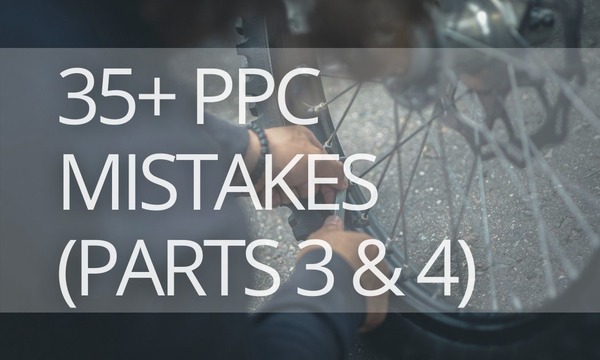
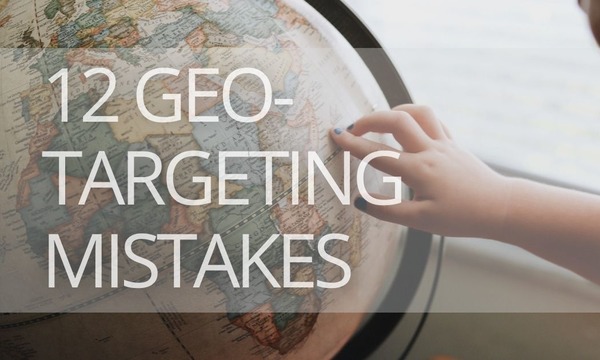
![How to Set up Remarketing in Google Ads [Ultimate Guide]](https://blog.promonavigator.com/wp-content/uploads/2021/09/remarketing-600-360.jpg)